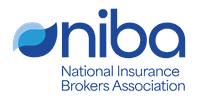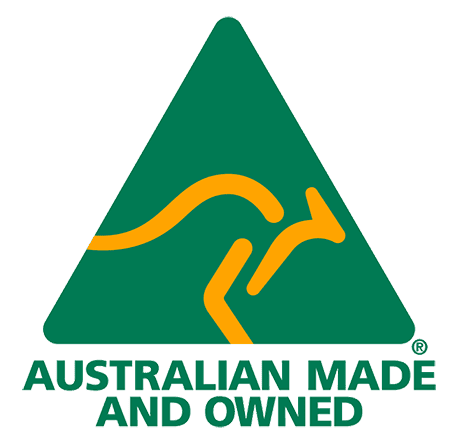Aviation Insurance Hobart & Tasmania
Tailored Aviation Insurance for Hobart Pilots, Operators & Businesses
When thinking about busy airports, Tasmania might not be the first that comes to mind. However, Hobart and its surrounding airfields keep the island state connected in ways few places can match.
Do you manage a light aircraft for business travel, operate a charter service for tourists, run a helicopter for aerial work, or teach student pilots out of Cambridge Aerodrome? Whatever your mission, flying in Tasmania comes with challenges unique to the island, including unpredictable weather, short grass strips, and plenty of overwater routes. This is why having the right insurance is what’ll keep your business from stalling when things don’t go as planned.
At AGL Aviation Insurance Brokers, we understand that no two Tasmanian operators are alike.
With decades of aviation experience and direct access to Australia’s leading specialist insurers, we design policies that fit the way you actually fly. Our Hobart- and Tasmania-focused
aviation insurance services and solutions are built to protect your aircraft, your livelihood, and the continuity of your operations, so you can keep flying with confidence.
Get Your Free Aviation Insurance Quote Today!
What Makes Hobart and the Tasmanian Aviation Landscape Unique
Hobart Airport (IATA: HBA, ICAO: YMHB), located in Cambridge about 17 kilometres from Hobart CBD, is Tasmania’s primary air gateway.
With one main runway (12/30), it supports domestic flights across mainland Australia, occasional international flights (notably to Auckland), and special charter services, including flights to Antarctica. Just beside Hobart lies the Cambridge Aerodrome (YCBG), which is home to local scenic flight operators (e.g., Par Avion), the Aeroclub of Southern Tasmania, and helicopter operators servicing aerial work, tourism, and Antarctic support. Cambridge was historically Hobart’s main aerodrome before the current international airport opened in 1956.
Tasmania’s geography means many airstrips lie in rugged, remote terrain, such as Strahan and Queenstown on the west coast, the highlands and bush fields of the Central Plateau, and agricultural regions in the north. Operators often fly small aircraft, agricultural aircraft, helicopters for forestry work or firefighting, aerial survey planes (e.g., photogrammetry), or tourism scenic flights.
The route between Hobart and more remote locations like Flinders Island, King Island, or the Strahan airstrip is common. Several charter operators also serve the Tasman Peninsula, Bruny Island, Maria Island, and flights to wilderness lodges in the Southwest can involve short, rough-field landings. That means exposures like runway overrun, damaged prop, fuel starvation, or forced landings in terrain are genuine risk scenarios.
In summer, aerial firefighting and bushfire support aircraft become active in Tasmania’s uplands and forests. There are also occasional flights from Hobart to Antarctica via Skytraders, using a jet aircraft for scientific missions.
In short, operating aviation in Hobart and other parts of Tasmania demands underwriting that accommodates remote operations, variable weather, short and unimproved strips, and seasonal mission profiles. That’s exactly what AGL Aviation Insurance Brokers aims to deliver.
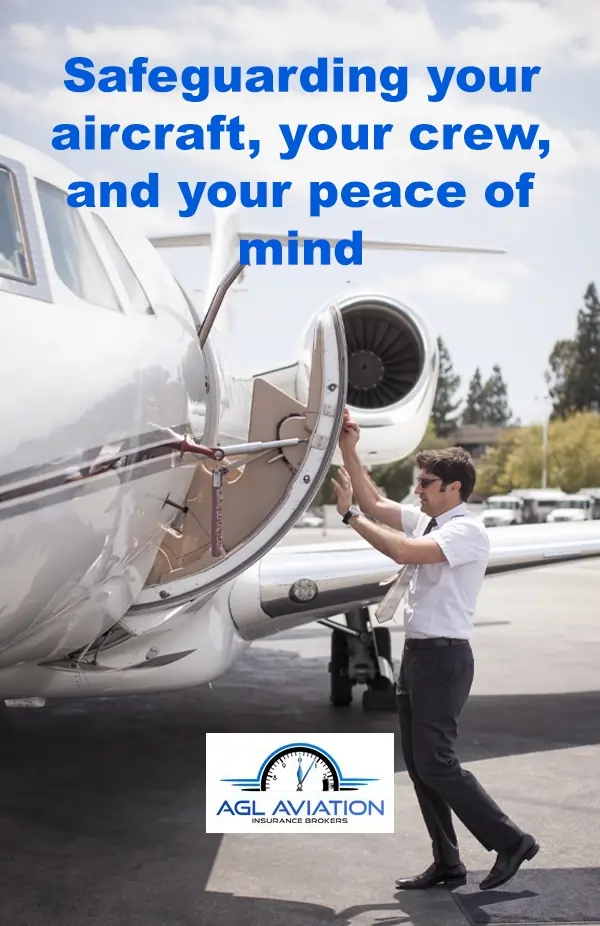
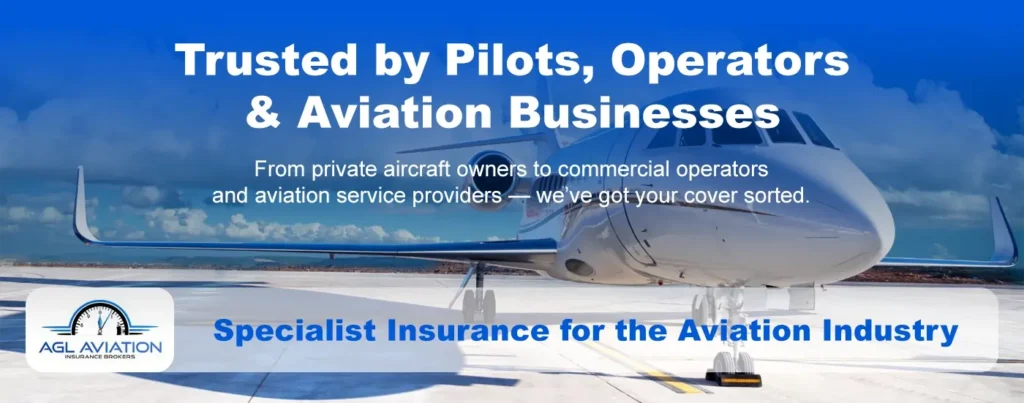
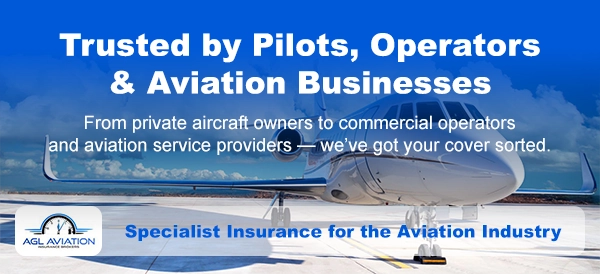
Who We Help
At AGL Aviation Insurance Brokers, we work closely with aircraft owners and aviation businesses across Hobart and throughout Tasmania.
Our experience on the ground, from the Cambridge Aerodrome to Launceston, Devonport, and the island’s regional strips, gives us a clear understanding of how Tasmanian flying conditions differ from those on the mainland. Variable weather, shorter runways, and the island’s rugged geography all shape how operators here manage risk.
▶ Private Aircraft Owners
Private owners face challenges such as limited hangar space, unpredictable coastal winds, and overwater routes to King and Flinders Islands. We design cover that fits your aircraft type and usage, whether you’re flying short scenic hops, business trips to the mainland, or weekend getaways around Tasmania.
▶ Commercial Operators
Charter flights play a major role in keeping Tasmania connected to the rest of the country. From business and government travel out of Hobart to regional runs linking Launceston, Strahan, and the Bass Strait islands, local operators deal with demanding conditions and time-sensitive schedules. Our policies for commercial operators cover hull, liability, and passenger risks, with options tailored to multi-aircraft fleets or single-aircraft charter businesses. We also consider factors like variable passenger loads, short- field operations, and wet or windy conditions common in Tasmanian aviation.
▶ Flight Schools & Instructors
Flight training in Tasmania offers spectacular scenery and challenging conditions. Schools based at Cambridge Aerodrome, Launceston Airport, and Devonport teach students through rapidly changing weather, controlled and uncontrolled airspace, and crosswind landings. We provide insurance solutions that reflect the realities of flight instruction: frequent aircraft utilisation, instructor liability, student pilot operations, and multi-aircraft fleets. Coverage can also extend to simulators, ground training facilities, and maintenance equipment.
▶ Aerial Survey & Photography
Tasmania’s varied terrain and environmental priorities drive demand for aerial survey, mapping, and photography, with risks tied to low-level flying, expensive onboard sensors, and data equipment. Our insurance options protect not just the aircraft, but also the high-value technology you rely on, including cameras, LiDAR sensors, and GPS systems, with coverage adaptable for both fixed-wing and rotary aircraft.
▶ Agricultural Aviation Operators
Agricultural aviation operators handle spraying, seeding, and feral animal control, often working from short or unsealed airstrips and flying at low altitude over uneven terrain. AGL provides policies designed for the realities of ag work: from chemical liability and payload coverage to equipment damage (e.g., commercial drones) and pilot injury. We account for the physical and operational pressures of rural flying and ensure you’re protected through seasonal peaks.
▶ Rotary Wing Operators
Rotary aircraft face unique wear and tear, frequent landings, and mission-specific risks that fixed-wing policies often overlook. We tailor cover for helicopter operators working in charter, corporate, emergency response, or aerial work. Our policies can include hull and liability protection, crew and passenger injury cover, and specialised endorsements for external load or sling operations.
Aviation Activities We Cover in Hobart & Tasmania
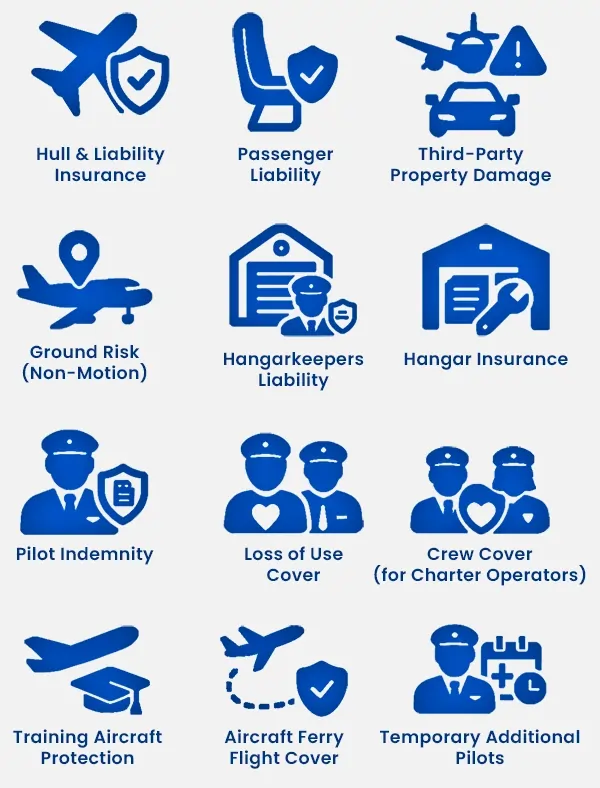
Flying in Tasmania is as diverse as its rugged natural landscape. From scenic helicopter tours over Wineglass Bay to crop-dusting runs in the Midlands and business charters linking Hobart with Melbourne or Launceston, every pilot and operator flies with a different mission. At AGL Aviation Insurance Brokers, we make sure your coverage matches how and where you actually fly.
We provide coverage for:
Private Flying: For recreational pilots taking coastal hops from Hobart to Strahan, scenic loops around Bruny Island, or quick flights between regional airstrips like Cambridge and Devonport. We provide tailored coverage for private fixed-wing aircraft, light sport planes, and privately owned helicopters used for leisure or personal travel.
Charter & Tourism Flights: The Tasmania tourism industry relies heavily on air transport, whether it’s luxury wine tours around the Coal River Valley or wilderness flights into the Southwest National Park. We offer insurance for fixed-wing and rotary operators running on- demand or scenic charter flights, covering both passengers and aircraft across Tasmania’s unique terrain.
Cargo & Freight: Operators handling goods in transit between Hobart, King Island, and the mainland contend with tight schedules and weather-sensitive routes. Our freight insurance policies protect against damage, delay, and operational risks for time-critical cargo services, including perishables and high-value freight.
Flight Training: Flight schools at Cambridge Aerodrome, Launceston, and Devonport train the next generation of pilots in challenging conditions, so we provide cover for student operations, instructor liability, multi-aircraft fleets, and training equipment.
Agricultural Flying: Tasmania’s farming regions are extensive, from the Derwent Valley to the North-West, and they rely on aviation for spraying, seeding, and pest management. Our policies account for low-level flying, chemical application, payload liability, and hull risks tied to rough or uneven strips.
Survey & Aerial Photography: From mapping forestry areas and power lines to capturing aerial footage of Hobart’s waterfront, operators need coverage that extends to their onboard tech. We protect not only the aircraft but also your imaging, LiDAR, and GPS equipment used for survey or commercial photography missions.
Emergency Medical Transport: Helicopters and fixed-wing aircraft providing air ambulance and emergency retrieval services operate under extreme pressure. We offer insurance that factors in medical equipment, crew liability, and the demanding nature of these flights across Tasmania’s often rugged and isolated areas.
Specialised Airwork: We also cover operators conducting essential air work, such as firefighting, powerline inspections, search and rescue, and environmental monitoring. Our coverage can be customised to suit high-risk or mission-specific operations across Tasmania’s unique geography.
Hobart Aviation Insurance Costs–What to Expect
The cost of aviation insurance in Hobart and Tasmania depends on several factors: the aircraft type, how it’s flown, and where it’s based. Tasmania’s coastal weather systems, mountain terrain, and exposure to strong winds can all influence premiums.
Here’s a general guide for estimating annual insurance costs:
- Light piston aircraft (Cessna 172, Piper Archer): AUD 2,500–7,000 per year, depending on aircraft use, storage, and pilot experience.
- Twin-engine aircraft (Baron, Seneca): AUD 5,000–10,000+, depending on operations such as charter, private use, or freight.
- Turboprops (King Air, Pilatus PC-12): AUD 10,000–25,000+, reflecting higher hull values and roles such as medevac, business charter, or survey work.
- Helicopters (Robinson R44, Bell 206, Airbus H125): Starting from AUD 7,000+, with premiums influenced by mission type (tourism, aerial work, or training) and landing sites.
| Aircraft Type | Example Model | Estimated Premium Range Per Annum (AUD) | Remarks |
|---|---|---|---|
| Light piston aircraft | Cessna 172 | 2,500 – 7,000 | Basic hull and liability cover; depends on usage |
| Twin piston aircraft | Piper Seneca | 5,000 – 10,000 | Higher value, more complex; pilot experience matters |
| Turboprop | King Air 200 | 10,000 – 25,000+ | More expensive due to higher value and complexity |
| Helicopter | Bell 206 | 7,000+ | Risk profile and operational use impact helicopter insurance premium |
*NOTE: Pilot experience is a significant factor in the above costs.
What Shapes Premiums in Tasmania
Tasmania’s aviation environment is unique. The area’s characteristic unpredictable weather, coastal conditions, and mixed-use airfields all factor into how insurers assess risk. Common influences on premiums include:
- Aircraft type, age, and insured value – Newer aircraft or those fitted with advanced avionics may receive better rates.
- Pilot experience – Hours logged in Tasmanian airspace or challenging environments such as crosswinds or IFR conditions help lower costs.
- Base location and storage – Aircraft kept in secure hangars at Cambridge or Launceston generally attract lower premiums than those parked outdoors at smaller regional strips.
- Type of operation – Charter, agricultural, and training flights typically have higher exposure levels than private or recreational use.
- Operational environment – Overwater flights, mountainous terrain, and frequent landings on unsealed strips can all affect premiums.
At AGL, we don’t rely on off-the-shelf pricing. We review your aircraft’s actual operations, pilot profiles, and base conditions, then negotiate with Australia’s specialist underwriters to secure the right balance of protection and value.
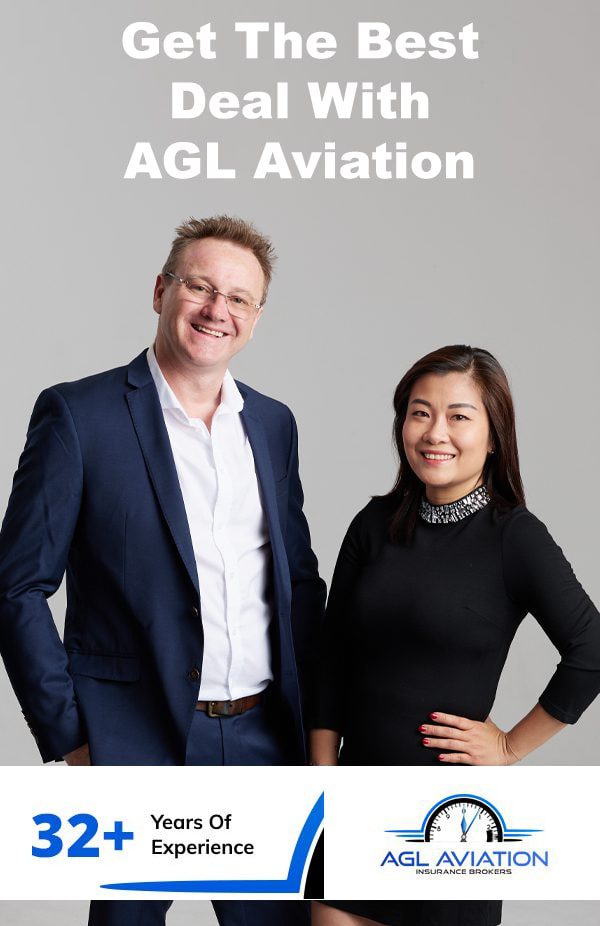
Why Hobart Aviators Trust AGL Aviation
Flying across Hobart and other parts of Tasmania comes with its own challenges and rewards. From Bass Strait crossings to unpredictable coastal weather and short regional runways, experience counts when choosing an aviation insurance partner. AGL Aviation Insurance Brokers has long supported Tasmanian operators, providing local knowledge backed by national reach.
Specialist Aviation Expertise: We don’t just understand aviation. We live and breathe it. Our brokers have worked with everyone from local aero clubs at Cambridge and Devonport to operators flying to King Island and Flinders Island.
Local Insight That Matters: Flying in Tasmania isn’t like flying on the mainland. Fog, sea winds, and hilly terrain make for unique operational risks. We understand the nuances of operating out of Hobart Airport’s GA precinct, navigating Tasmanian coastal routes, and working around the island’s rapidly changing weather systems.
Strong Underwriter Partnerships: Because we deal directly with leading aviation underwriters, we can source cover for complex or unusual risks, such as charter flights over remote wilderness areas, agricultural spraying, or medevac operations from the West Coast. Our network helps ensure our clients get competitive premiums and dependable protection.
Fast, Practical Support: We know timing is everything in aviation. That’s why we prioritise fast quotes (usually within 1–2 business days) and swift policy renewals. If your operations expand, shift, or take on new aircraft, we’re quick to adjust your coverage so you can keep flying without interruption.
Personalised Service, Every Time: You won’t get shuffled through a call centre. When you call AGL, you speak directly with aviation insurance specialists who understand CASA requirements, maintenance realities, and the day-to-day of running aircraft in Tasmania.
Coverage Beyond Hobart: Many of our clients operate statewide or across the Bass Strait. We make sure your policy follows you, whether you’re flying charters to Launceston, freight to Burnie, or sightseeing tours over Cradle Mountain.
How to Get Started
Get a Quote From AGL
No matter where you’re flying from, local aviation hubs, or any regional airfield across Tasmania (or even Melbourne, Adelaide, Brisbane, Sydney, Darwin, and Canberra), AGL Aviation Insurance Brokers is ready to help.
Step 1: Contact us via phone, online form, or email.
Step 2: Provide basic details about your aircraft and how it’s used.
Step 3: Get a tailored quote quickly.
Reach out to AGL Aviation Insurance Brokers today to discuss your aircraft and operational profile. We’ll provide a quick turnaround on quotes and guide you through the next steps.
We not only provide policies but also ensure you understand what they do, what they don’t do, and how they fit your aircraft’s life cycle.
Get Your Free Aviation Insurance Quote Today!
Fill Out Our Form for Your Custom Aviation Insurance Quote Today
Frequently asked questions
FAQs – Hobart & Tasmania Aviation Insurance
Navigating aircraft insurance can raise a few questions — especially here in Hobart, where needs can vary widely. Our FAQ section is designed to clear up the confusion, answer your most common queries, and guide you confidently through the details. Dive in and get the clarity you need.
Yes, as long as over-water exposure is declared and suitable “marine/rescue” or ditching coverage is included. We’ll assess route lengths, alternates, and weather risks to set terms.
It can, since flying over rugged terrain with limited diversion options elevates risk. We’ll ask for route maps, altitude profiles, and mitigation measures (e.g., autorotation training) to calibrate your premium.
We often offer a seasonal endorsement: for months when firefighting is active, your coverage limits or deductibles may be adjusted temporarily, after which they revert. This helps contain premium charges outside the high-risk period.
Yes, provided that the strip is declared in your schedule, inspected, and meets safety criteria. Damage to the aircraft and associated liability (if the fence belongs to a third party) would be managed under hull + liability.
Yes. Location changes can shift exposure (e.g., different airspace, different runway types). We’ll reassess the premium and possibly issue an endorsement.
We regularly monitor Hobart Airport upgrades (e.g., runway extension, terminal expansion) and may propose adjustments to cover or offer discounted revaluation for clients who benefit from improved infrastructure.
Didn’t find the answers to your questions? Don’t hesitate to contact us.







